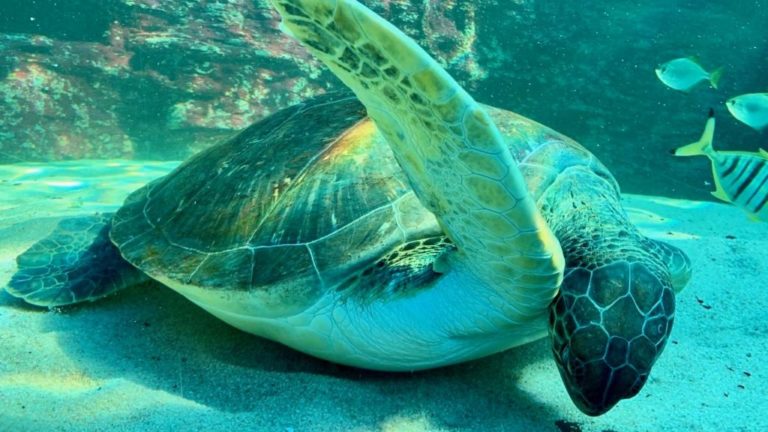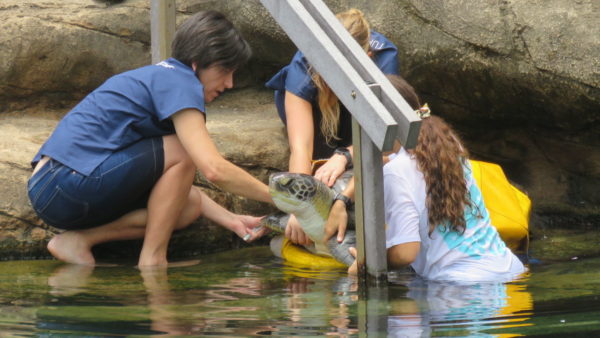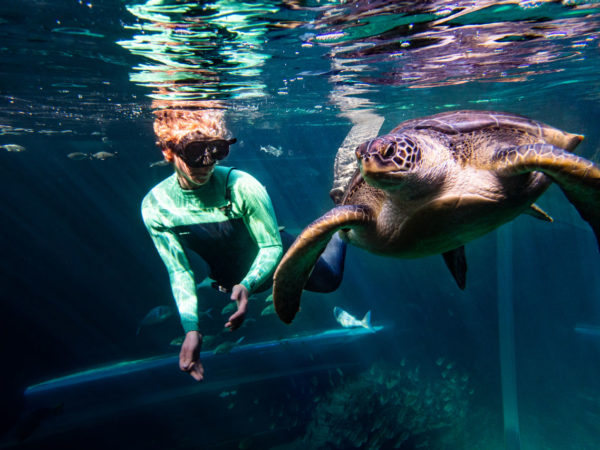[ad_1]
After eight years of rehabilitation, a successful release and 97 days of tracking Bob in the great blue ocean, the Two Oceans Aquarium Foundation has revealed some exciting news: Bob is a girl!

Laura du Toit, Two Oceans Aquarium’s content marketing coordinator, revealed all of the details about this exciting development.
According to the write-up, the Turtle Conservation Centre’s specialised turtle vet, Dr Bernice van Huyssteen, said that it can be challenging to determine a turtle’s sex. By taking a blood sample for a DNA (genetic) test, which is an easy and accessible test, it is possible to determine the sex of the majority of animals. However, this kind of testing is insufficient for turtles.
‘In sea turtles, the males and females are genetically the same,’ explained Dr Bernice. ‘Turtles’ sexes are determined by the temperature of the sand in which they hatch: if the eggs incubate at temperatures below 27.7°C, they will be male, while temperatures above 31°C will result in more female hatchlings. Therefore, male and female turtles’ genetics are the same. This is called temperature-dependent sex determination.’
Other methods of determining the sex of juvenile turtles are also difficult. Turtles’ sex organs (ovaries in females and testes in males) look very similar on ultrasound examination before they reach maturity.
So the veterinary team at Two Oceans Aquarium faced the dilemma of determining Bob’s sex as a relatively immature green turtle. Dr Bernice came across a 2015 study that used testosterone levels to determine whether green turtles were male or female during her research. Higher testosterone levels indicate a male turtle, while lower levels indicate a female turtle. The study’s reliability was demonstrated when the results were confirmed when the turtles in the study matured.
The veterinary team took blood samples from Bob on the day she was released. This was put on hold while they conducted sex determination research and planned the tests. Dr Bernice delivered the frozen blood sample to Pretoria’s specialist endocrine laboratory, where the testosterone test was performed.
Finally, the Two Oceans Aquarium team compared Bob’s testosterone levels to the study’s normal ranges for males and females. It was determined that Bob is female!

Dr Bernice conducted a medical check and took a blood sample before Bob’s release. Picture: Two Oceans Aquarium Foundation
What does this mean for Bob?
‘One day, Bob will hopefully return to the beach where she hatched to bring forth a new generation of turtles!’ said Dr Bernice.
Prior to the test results, the Turtle Conservation Centre team assumed there would be little tangible evidence of Bob’s future movements; male turtles rarely come ashore and spend the majority of their lives at sea, whereas females return to the same beach every few years to nest.
The Two Oceans Aquarium Foundation is excited about the possibility of Bob coming ashore to nest now that her sex has been confirmed as female. They may be able to observe her because she is equipped with a satellite, flipper and acoustic tags. Female green turtles, like Bob, lay up to 2 300 eggs in their lifetime and nest every two to three years.
Talitha Noble, manager of the Turtle Conservation Centre and one of Bob’s primary carers, was overjoyed with the news.
She said, ‘There’s a chance Bob will be spotted on the beach when she (hopefully) nests one day, and we could continue our journey with her. We could even retag her to continue tracking her movements! The idea of lots of little Bobbies in the world is an exciting one!’
How does the turtle team feel about the results?
According to du Toit, Dr Bernice was ecstatic to learn that Bob was female.
‘In the past, we have tried to determine her sex via ultrasound without success. It was so great to finally get an answer! I was very pleased that the test worked and that we got an accurate result,’ said Dr Bernice.
du Toit explained that this test establishes a precedent for future sex determinations of green turtles at the Turtle Conservation Centre.
According to Dr Bernice, Bob is the first turtle in South Africa whose sex has been successfully confirmed via testosterone testing. This is a huge accomplishment for the Turtle Conservation Centre, which frequently works with stranded green turtles.
The turtle team will be able to contribute to the scientific database on population demographics by using testosterone tests on stranded green turtles. Testosterone testing also adds to their understanding of the conservation status of green turtles.

Talitha Nobe with Bob during her rehabilitation. Picture: Two Oceans Aquarium Foundation
Du Toit wrote, ‘Bob’s journey highlights the importance of our work at the Turtle Conservation Centre. Bob arrived as an injured little turtle, quickly becoming an anti-plastic ambassador and a beloved member of the aquarium family. Now, she has the potential to mother a new generation of green turtles. This story shows why rehabilitation is so important: after eight years of care, enrichment and treatment, Bob went from being “unreleasable” (a hopeless case) to possibly continuing the green turtle species in the wild.’
Is Bob’s name going to change?
Bob will always be Bob to the Two Oceans Aquarium family, according to Du Toit, and they think she should stay that way!
Written by Sarah du Toit
Follow us on social media for more travel news, inspiration, and guides. You can also tag us to be featured.
TikTok | Instagram | Facebook | Twitter
ALSO READ: Bob crosses the Agulhas Bank into waters that are 3000m deep
[ad_2]
Source link
Jarastyle – #Oceans #Aquarium #reveals #Bob #turtle #girl
Courtesy : https://www.getaway.co.za/travel-news/breaking-news-two-oceans-aquarium-reveals-bob-the-turtle-is-a-girl/

